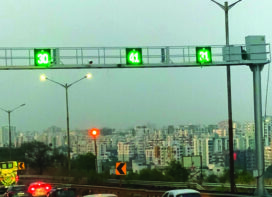Letting freight trains take the strain
Using smart sensors makes rail freight operations more secure too. Sensors enable geolocation and monitor freight wagons and their contents, providing data such as interior temperature and humidity, the distances travelled and impacts the wagons and contents experience.
Triaxial acceleration sensors measure the force, frequency and precise position of the shocks that can occur during shunting and loading or unloading, and GPS sensors allow the location of each freight wagon to be determined with great accuracy. This saves costs, improves logistics planning and ensures punctual delivery. Much of this technology can be retrofitted.
These smart sensors give customers real-time data on the condition and security of goods in transit, as well as their expected arrival times. The condition of wagons and freight can be checked at any time, enhancing efficiency in the logistics chain and in the scheduling of maintenance and repair work.
The largest US freight network, Union Pacific, has designed its own state-of-the art rolling stock inspection system known as ‘Machine Vision’. This comprises an array or “portal” containing a combination of fault detection sensors, infrared cameras and line scan cameras, lasers and strobes. Three of these systems are in operation at different US locations, collecting various types of data from wheel detectors, lasers, cameras and light detection and ranging (LiDAR) technology. Each portal is able to identify and measure 22 wagon ‘components’ and flag up defects that could lead to a delay or a derailment.
Track to the Future
SCI Verkehr forecasts that urban rail will see the strongest growth in the next decade, followed by mainline passenger traffic. Urban rail will grow at an average of 5% per year until 2025, with high growth rates in China and in Central and South America. Growth is expected to tail off after 2020 as many metro and light rail projects are completed.
Europe currently has the largest revenue share of the smart railway market, followed by North America. Asia-Pacific is forecast to be the fastest growing region in the next decade, with China and Japan driving the expansion of smart railway technology and services. Almost USD 30 billion is projected to be spent during the next 15 years on the application of IoT technology in the global railway industry, according to a forecast in August 2017 by Research and Markets, a Dublin-based business intelligence firm.
The prospect of a future in which driverless cars are commonplace could adversely affect passenger train services.
In October 2017, the global mining giant Rio Tinto successfully completed a 62 mile autonomous train journey transporting iron ore in Western Australia, another step towards its vision of fully self driving long-distance freight train operations. In China the China Railway Rolling Stock Corporation (CRRC), one of the world’s largest train manufacturers, is testing what it describes as “trackless trains” on the streets of Zhuzhou, Hunan Province. According to Chinese state media, the electric powered vehicles are a cross between a tram and a bus. They run on “virtual railway tracks” marked out by dotted lines painted on the road and use sensors to collect travel information, identify pavements and determine their own route.
If the railway industry is to compete successfully for passengers, the trains of tomorrow will have to be not merely faster and more efficient, but also comfortable and attractive to travel on. “In future information and entertainment on trains will be more comprehensive and ubiquitous, while passengers will be better connected though satellite networks”, predicts David Briginshaw, editor-in-chief of the International Railway Journal. TC 9 already addresses this issue through Working Group, WG 46: Onboard multimedia systems for railways.
Smart may present risks…
Increased connectivity also turns the rail industry into a viable target for hackers. The enormous quantity of data captured by the growing number of devices, processes and services integrated in smart railways makes cyber security a compelling issue. Operators will need to guard against cyber attacks to avoid losing control of the operational aspects of trains and of the data sets themselves. IEC TC 9 is keenly aware of the cyber threats on railways. It takes part in work by the IEC Advisory committee on information security and data privacy (ACSEC) and is in the process of setting up an ad hoc group to address cyber issues in the railway sector.
Peter Feuilherade is a UK-based writer and regular contributor to the IEC publication e-tech.
 TrafficInfraTech Magazine Linking People Places & Progress
TrafficInfraTech Magazine Linking People Places & Progress


